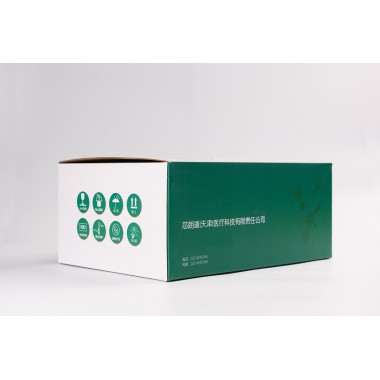1.Product Overview
[product name] : Whole process C-reactive protein (hs CRP+conventional CRP)
[Package Specification] :30 tests/kit;60 tests/kit
[Applicable Device] : CLite-160i
[Specimen Type] : serum
[Storage] : 2-8℃
[Product validity] : 12 months
[Detection method] : magnetic particle chemiluminescence method
2.technique principle
Double antibody sandwich method was used in the kit. The detection principle is: the sample to be tested, R1 reagent, R2 reagent and M reagent are mixed for incubation, and the fluorescein (FITC) labeled CRP antibody 1 in R1 reagent and the alkaline phosphatase (ALP) labeled CRP antibody 2 in R2 reagent are combined with the CRP antigen molecules in the sample to form an immune complex. The immune complex is further captured by anti-FITC antibodies coupled to the surface of the magnetic particle and adsorbed to the surface of the magnetic particle. After washing, the unbound material was removed and the luminescent substrate was added, ALP catalyzed the luminescence of the substrate, and the relative luminescence intensity (RLU) was determined
3.The clinical significance
1). Diagnosis and differentiation of infection: Routine C-reactive protein testing plays an important role in determining the degree of bacterial or viral infection, treatment effectiveness, and prognosis. CRP starts to rise 6-8 hours after bacterial infection occurs, reaches its peak at 24-48 hours, and its content drops sharply after the infection is eliminated. It can return to normal within a week. CRP did not significantly increase during viral infection.
2). At present, the determination of hypersensitive C-reactive protein in clinical practice dynamically monitors coronary heart disease and unstable angina to predict the risk of myocardial infarction. When hypersensitive C-reactive protein>2.1 mg/L: ① The risk of initial myocardial infarction increases threefold. ② The risk of bleeding and stroke increases by two times The risk of developing severe peripheral arterial vascular disease increases by four times
3). Autoimmunity or immune complexes: systemic lupus erythematosus, polymyositis, and systemic sclerosis have no significant changes in CRP, so they can be used to differentiate from rheumatic diseases. If there is fever, it is a concurrent infection rather than a worsening of the disease.
4). Cancer: Elevated or ongoing CRP indicates poor prognosis and often indicates metastasis. Colon cancer is the second most deadly cancer. Research has shown that those with the highest levels of C-reactive protein in their blood are at twice the risk of developing colorectal cancer compared to those with the lowest levels of C-reactive protein.
5). Assess disease activity and efficacy monitoring: CRP of 10-50mg/L indicates mild inflammation. A CRP increase of 100 mg/L indicates a more serious disease, and its severity may require intravenous injection if necessary. CRP>100mg/L indicates a serious disease process and often indicates the presence of bacterial infections.
6). Antibiotic treatment monitoring: Antibiotic treatment is most effective in many infections. Determine the dosage of anti-inflammatory drugs based on changes in CRP levels.
7). Surgery: 24-72 hours after surgery, the CRP level in the blood significantly increases and returns to normal around 5-7 days. Continuous high levels after a sudden rise often indicate concurrent infection.
Therefore, CRP detection is widely used in clinical practice, including the diagnosis and differential diagnosis of acute infectious diseases, and the monitoring of postoperative infection; Observation of antibiotic efficacy; Disease course detection and prognosis judgment, etc.
4. Product features and indicators
High sensitivity: the detection limit is not higher than0.1mg/L;
Wide linear range: samples in the range of 0.1~200.0 (mg/L) do not need to be diluted;
Good correlation: c correlation R > 0.95 with Beckman reagent;
Good stability: the calibration cycle can be up to 14 days, and the reagent can be stored at 4℃ for 1 year.
Fast results: only 16-18 minutes to get results.







